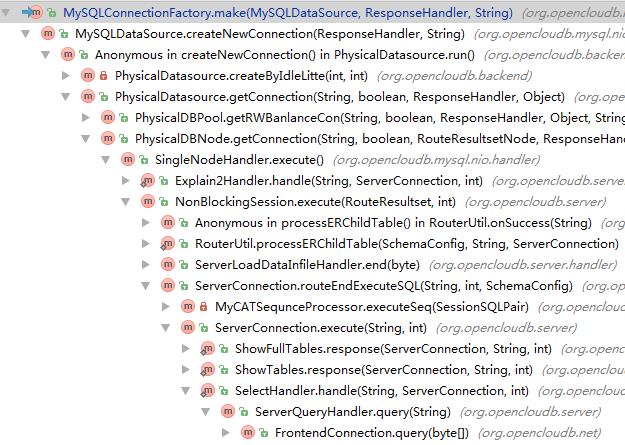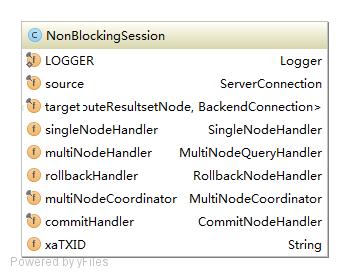数据库路由中间件MyCat - 源代码篇
Posted 163yun
tags:
篇首语:本文由小常识网(cha138.com)小编为大家整理,主要介绍了数据库路由中间件MyCat - 源代码篇相关的知识,希望对你有一定的参考价值。
此文已由作者张镐薪授权网易云社区发布。
欢迎访问网易云社区,了解更多网易技术产品运营经验。
3. 连接模块
3.5 后端连接
3.5.1 后端连接获取与负载均衡
上一节我们讲了后端连接的基本建立和响应处理,那么这些后端连接是什么时候建立的呢? 首先,MyCat配置文件中,DataHost标签中有minIdle这个属性。代表在MyCat初始化时,会在这个DataHost上初始化维护多少个连接(这些连接可以理解为连接池)。每个前端Client连接会创建Session,而Session会根据命令的不同而创建不同的Handler。每个Handler会从连接池中拿出所需要的连接并使用。在连接池大小不够时,RW线程会异步驱使新建所需的连接补充连接池,但是连接数最大不能超过配置的maxCon。同时,如之前所述,有定时线程检查并回收空闲后端连接。但池中最小不会小于minCon。 我们可以通过后端连接的工厂方法的调用链来理解:  看这个调用链,我们简述下大概的流程。
看这个调用链,我们简述下大概的流程。
st=>start: MyCat接受客户端连接并为之建立唯一绑定的Session e=>end: 将请求发送给对应连接,处理完之后归还连接 op1=>operation: MyCat接受客户端的请求,计算路由 op2=>operation: 根据请求和路由创建合适的handler,这里为SingleNodeHandler op3=>operation: 从PhysicalDBNode中获取后端连接 cond=>condition: 尝试获取连接,连接够用? op4=>operation: 尝试异步创建新的连接 op5=>operation: 通过DelegateResponseHandler将连接与之前的Handler,这里是SingleNodeHandler绑定 st->op1->op2->op3->condcond(yes)->econd(no)->op4->op5->e
我们先从Session看起,在MyCat中实现类为NonBlockingSession。在前端连接建立时,会创建绑定唯一的Session: ServerConnectionFactory.java:
protected FrontendConnection getConnection(NetworkChannel channel) throws IOException {
SystemConfig sys = MycatServer.getInstance().getConfig().getSystem();
ServerConnection c = new ServerConnection(channel);
MycatServer.getInstance().getConfig().setSocketParams(c, true);
c.setPrivileges(MycatPrivileges.instance());
c.setQueryHandler(new ServerQueryHandler(c));
c.setLoadDataInfileHandler(new ServerLoadDataInfileHandler(c)); // c.setPrepareHandler(new ServerPrepareHandler(c));
c.setTxIsolation(sys.getTxIsolation()); //创建绑定唯一Session
c.setSession2(new NonBlockingSession(c)); return c;
}Session主要处理事务,多节点转发协调等,由不同的ResponseHandler实现;  这些ResponseHandler我们之后会在对应的模块去细细分析。这里先跳过。 查看SingleNodeHanlder的处理方法 SingleNodeHanlder.java:
这些ResponseHandler我们之后会在对应的模块去细细分析。这里先跳过。 查看SingleNodeHanlder的处理方法 SingleNodeHanlder.java:
public void execute() throws Exception { //从这里开始计算处理时间
startTime=System.currentTimeMillis();
ServerConnection sc = session.getSource(); this.isRunning = true; this.packetId = 0; final BackendConnection conn = session.getTarget(node); //之前是否获取过Connection并且Connection有效
if (session.tryExistsCon(conn, node)) {
_execute(conn);
} else { // create new connection
MycatConfig conf = MycatServer.getInstance().getConfig(); //从config中获取DataNode
PhysicalDBNode dn = conf.getDataNodes().get(node.getName()); //获取对应的数据库连接
dn.getConnection(dn.getDatabase(), sc.isAutocommit(), node, this,
node);
}
}从PhysicalDBNode中获取合适的连接:
public void getConnection(String schema,boolean autoCommit, RouteResultsetNode rrs,
ResponseHandler handler, Object attachment) throws Exception {
checkRequest(schema); //检查数据库连接池是否初始化成功,因为有reload命令
if (dbPool.isInitSuccess()) { //根据是否能在读节点上运行获取连接,一般是判断是否为读请求,并且读请求不在事务中
if (rrs.canRunnINReadDB(autoCommit)) { //根据负载均衡策略选择合适的后端连接
dbPool.getRWBanlanceCon(schema,autoCommit, handler, attachment, this.database);
} else { //直接选择当前连接池中的的后端连接
dbPool.getSource().getConnection(schema,autoCommit, handler, attachment);
}
} else { throw new IllegalArgumentException("Invalid DataSource:"
+ dbPool.getActivedIndex());
}
}PhysicalDBPool类中有负载均衡,切换writeHost,控制write方式等(分别对应balance,writeType等标签)的实现。首先我们看如果有负载均衡策略(配置了balance)的获取连接的方式:
public void getRWBanlanceCon(String schema, boolean autocommit,
ResponseHandler handler, Object attachment, String database) throws Exception {
PhysicalDatasource theNode = null;
ArrayList<PhysicalDatasource> okSources = null; switch (banlance) { //所有读写节点参与read请求的负载均衡,除了当前活跃的写节点,balance=1
case BALANCE_ALL_BACK: { //返回所有写节点和符合条件的读节点,不包括当前的写节点
okSources = getAllActiveRWSources(true, false, checkSlaveSynStatus()); if (okSources.isEmpty()) { //如果结果即为空,返回当前写节点
theNode = this.getSource();
} else { //不为空,随机选一个
theNode = randomSelect(okSources);
} break;
} //所有读写节点参与read请求的负载均衡,balance=2
case BALANCE_ALL: { //返回所有写节点和符合条件的读节点
okSources = getAllActiveRWSources(true, true, checkSlaveSynStatus()); //随机选一个
theNode = randomSelect(okSources); break;
} case BALANCE_ALL_READ: { //返回所有符合条件的读节点
okSources = getAllActiveRWSources(false, false, checkSlaveSynStatus()); //随机取一个
theNode = randomSelect(okSources); break;
} //不做负载均衡,balance=0或其他不为以上的值
case BALANCE_NONE: default:
// return default write data source
theNode = this.getSource();
} if (LOGGER.isDebugEnabled()) {
LOGGER.debug("select read source " + theNode.getName() + " for dataHost:" + this.getHostName());
}
theNode.getConnection(schema, autocommit, handler, attachment);
}其中涉及到的方法:
返回符合条件节点集:
private ArrayList<PhysicalDatasource> getAllActiveRWSources( boolean includeWriteNode, boolean includeCurWriteNode, boolean filterWithSlaveThreshold) { int curActive = activedIndex;
ArrayList<PhysicalDatasource> okSources = new ArrayList<PhysicalDatasource>(this.allDs.size()); //判断写节点
for (int i = 0; i < this.writeSources.length; i++) {
PhysicalDatasource theSource = writeSources[i]; //判断写节点是否是active,可能reload会置为inactive,可能多个写节点但是只有一个是活跃在用的(writeType=0)
if (isAlive(theSource)) { //负载均衡策略是否包含写节点
if (includeWriteNode) { //判断是否包含当前活跃的写入节点
if (i == curActive && includeCurWriteNode == false) { // not include cur active source
} else if (filterWithSlaveThreshold) { //如果包含从节点同步延迟限制,检查同步状态
if (canSelectAsReadNode(theSource)) {
okSources.add(theSource);
} else { //如果同步状态不对,则不添加这个写节点
continue;
}
} else {
okSources.add(theSource);
}
} //检查theSource对应的读节点
if (!readSources.isEmpty()) { // 检查theSource对应的读节点(从节点)
PhysicalDatasource[] allSlaves = this.readSources.get(i); if (allSlaves != null) { for (PhysicalDatasource slave : allSlaves) { if (isAlive(slave)) { //如果包含从节点同步延迟限制,检查同步状态
if (filterWithSlaveThreshold) { if (canSelectAsReadNode(slave)) { //如果同步状态正确,则把读节点加入
okSources.add(slave);
} else { continue;
}
} else {
okSources.add(slave);
}
}
}
}
}
} else { // TODO : add by zhuam
// 如果写节点不OK, 也要保证临时的读服务正常
if (this.dataHostConfig.isTempReadHostAvailable()) { if (!readSources.isEmpty()) { // check all slave nodes
PhysicalDatasource[] allSlaves = this.readSources.get(i); if (allSlaves != null) { for (PhysicalDatasource slave : allSlaves) { if (isAlive(slave)) { if (filterWithSlaveThreshold) { if (canSelectAsReadNode(slave)) {
okSources.add(slave);
} else { continue;
}
} else {
okSources.add(slave);
}
}
}
}
}
}
}
} return okSources;
}检查是否判断主从延迟:
private boolean checkSlaveSynStatus() { return (dataHostConfig.getSlaveThreshold() != -1)
&& (dataHostConfig.getSwitchType() == DataHostConfig.SYN_STATUS_SWITCH_DS);
}随机选择节点:
/**
* TODO: modify by zhuam
* <p/>
* 随机选择,按权重设置随机概率。
* 在一个截面上碰撞的概率高,但调用量越大分布越均匀,而且按概率使用权重后也比较均匀,有利于动态调整提供者权重。
*
* @param okSources
* @return
*/
public PhysicalDatasource randomSelect(ArrayList<PhysicalDatasource> okSources) { if (okSources.isEmpty()) { return this.getSource();
} else { int length = okSources.size(); // 总个数
int totalWeight = 0; // 总权重
boolean sameWeight = true; // 权重是否都一样
for (int i = 0; i < length; i++) { int weight = okSources.get(i).getConfig().getWeight();
totalWeight += weight; // 累计总权重
if (sameWeight && i > 0
&& weight != okSources.get(i - 1).getConfig().getWeight()) { // 计算所有权重是否一样
sameWeight = false;
}
} if (totalWeight > 0 && !sameWeight) { // 如果权重不相同且权重大于0则按总权重数随机
int offset = random.nextInt(totalWeight); // 并确定随机值落在哪个片断上
for (int i = 0; i < length; i++) {
offset -= okSources.get(i).getConfig().getWeight(); if (offset < 0) { return okSources.get(i);
}
}
} // 如果权重相同或权重为0则均等随机
return okSources.get(random.nextInt(length)); //int index = Math.abs(random.nextInt()) % okSources.size();
//return okSources.get(index);
}
}根据writeType获取当前writeHost方法:
public PhysicalDatasource getSource() { switch (writeType) { //writeType=0,返回当前active的writeHost
case WRITE_ONLYONE_NODE: { return writeSources[activedIndex];
} //writeType=1,随机发到一个writeHost
case WRITE_RANDOM_NODE: { int index = Math.abs(wnrandom.nextInt()) % writeSources.length;
PhysicalDatasource result = writeSources[index]; if (!this.isAlive(result)) { // find all live nodes
ArrayList<Integer> alives = new ArrayList<Integer>(writeSources.length - 1); for (int i = 0; i < writeSources.length; i++) { if (i != index) { if (this.isAlive(writeSources[i])) {
alives.add(i);
}
}
} if (alives.isEmpty()) {
result = writeSources[0];
} else { // random select one
index = Math.abs(wnrandom.nextInt()) % alives.size();
result = writeSources[alives.get(index)];
}
} if (LOGGER.isDebugEnabled()) {
LOGGER.debug("select write source " + result.getName()
+ " for dataHost:" + this.getHostName());
} return result;
} //参数不正确
default: { throw new java.lang.IllegalArgumentException("writeType is "
+ writeType + " ,so can‘t return one write datasource ");
}
}
}更多网易技术、产品、运营经验分享请点击。
相关文章:
【推荐】 InnoDB透明页压缩与稀疏文件
【推荐】 浅析电商防止恶意下单
以上是关于数据库路由中间件MyCat - 源代码篇的主要内容,如果未能解决你的问题,请参考以下文章